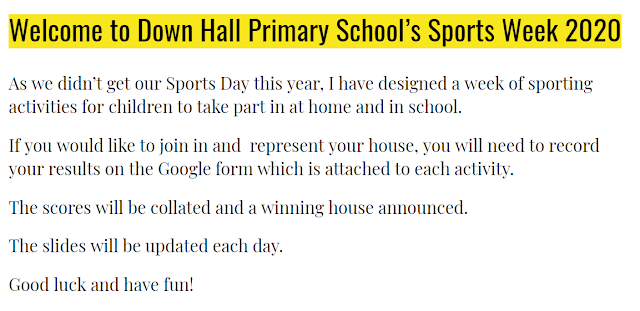

If you send your scores to our email ( ks1@downhallprimary.com) I will forward them to Miss Sharman. Please include your child's house - if you are not sure which one this is I can find out for you, don't worry!
Here is Monday's challenge - I will edit this blog and add in Tuesday's task as well, so if it is not here yet, check back later in the day:

This is the direct link to the Slides file if you wish to follow the file as it is updated or submit your score directly:
https://docs.google.com/presentation/d/1x3dl6ZD4AnjyGHnwa4a9DdPcLD0InOSyISd-v9IYyng/edit?ts=5f02e1e4#slide=id.p

History - Grace Darling
After sharing all your ideas about yesterday's picture, I can reveal that the famous person was the lady in the rowing boat; her name Grace Darling.
Watch this video below to learn all about this remarkable lady's adventure:
https://www.bbc.co.uk/programmes/p015gmjd
After watching this video, begin to see if you can sequence the events of 7th September 1838 and the wreck of the Forfarshire into an order. Can you sequence them into 6 events? I would start how there was a storm during the night - see if you can continue the next steps (I'll share mine tomorrow). Have a go and we'll do something with these events tomorrow.
I hope you enjoyed finding out about someone who displayed true heroism and altruism today.

Maths - Fractions as Division
Yesterday we looked at practical approaches to solve division calculations and identified how finding half is the same as dividing by 2. With this in mind we can use division to find fractions of amounts. All we need to do is look at the denominator (the bottom number in the fraction) and divide the amount into that many groups.
We can use this approach when finding fractions of shapes. Look at the shape below:

We need to find half. First, we can count the number of squares inside the shape.
There are 6.
Now as we are finding half, we share this amount between 2.

That gives us 3.
We can now colour this amount of squares in. It's worth noting that it doesn't matter which squares are coloured, just the number of coloured squares has to be 3.
Year 1's - Try this one. Look out for the quarters - you'll need to share between 4 for these ones:

Year 2's try this one. To find the answer, after sharing between the denominator (bottom number) and checking all groups are even, you need to count the number of groups show on the numerator (top number). So for three quarters, you need to count 3 groups.

Good luck and thank you for all your homeschooling efforts, no matter how small.
KS1 Team